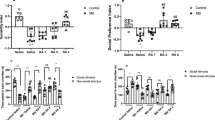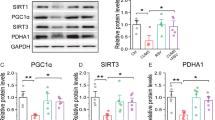Abstract
Rationale
Sepsis is a severe inflammatory response to infection that leads to long-lasting cognitive impairment and depression after resolution. The lipopolysaccharide (LPS)-induced endotoxaemia model is a well-established model of gram-negative bacterial infection and recapitulates the clinical characteristics of sepsis. However, whether LPS-induced endotoxaemia during adolescence can modulate depressive and anxiety-like behaviours in adulthood remains unclear.
Objectives
To determine whether LPS-induced endotoxaemia in adolescence can modulate the stress vulnerability to depressive and anxiety-like behaviours in adulthood and explore the underlying molecular mechanisms.
Methods
Quantitative real-time PCR was used to measure inflammatory cytokine expression in the brain. A stress vulnerability model was established by exposure to subthreshold social defeat stress (SSDS), and depressive- and anxiety-like behaviours were evaluated by the social interaction test (SIT), sucrose preference test (SPT), tail suspension test (TST), force swimming test (FST), elevated plus-maze (EPM) test, and open field test (OFT). Western blotting was used to measure Nrf2 and BDNF expression levels in the brain.
Results
Our results showed that inflammation occurred in the brain 24 h after the induction of LPS-induced endotoxaemia at P21 but resolved in adulthood. Furthermore, LPS-induced endotoxaemia during adolescence promoted the inflammatory response and the stress vulnerability after SSDS during adulthood. Notably, the expression levels of nuclear factor erythroid 2-related factor 2 (Nrf2) and BDNF in the mPFC were decreased after SSDS exposure in mice treated with LPS during adolescence. Activation of the Nrf2-BDNF signalling pathway by sulforaphane (SFN), an Nrf2 activator, ameliorated the effect of LPS-induced endotoxaemia during adolescence on stress vulnerability after SSDS during adulthood.
Conclusions
Our study identified adolescence as a critical period during which LPS-induced endotoxaemia can promote stress vulnerability during adulthood and showed that this effect is mediated by impairment of Nrf2-BDNF signalling in the mPFC.






Similar content being viewed by others
Data availability
Data arising from this study will be made freely available upon request.
References
Ahmed SM, Luo L, Namani A, Wang XJ, Tang X (2017) Nrf2 signaling pathway: pivotal roles in inflammation. Biochim Biophys Acta Mol Basis Dis 1863:585–597. https://doi.org/10.1016/j.bbadis.2016.11.005
Anderson ST, Commins S, Moynagh PN, Coogan AN (2015) Lipopolysaccharide-induced sepsis induces long-lasting affective changes in the mouse. Brain Behav Immun 43:98–109. https://doi.org/10.1016/j.bbi.2014.07.007
Annane D, Sharshar T (2015) Cognitive decline after sepsis. Lancet Respir Med 3:61–69. https://doi.org/10.1016/S2213-2600(14)70246-2
Banagozarmohammadi A, Torbati M, Farajdokht F, Sadigh-Eteghad S, Fazljou SMB, Vatandoust SM, Golzari SEJ, Mahmoudi J (2019) Sericin alleviates restraint stress induced depressive- and anxiety-like behaviors via modulation of oxidative stress, neuroinflammation and apoptosis in the prefrontal cortex and hippocampus. Brain Res 1715:47–56. https://doi.org/10.1016/j.brainres.2019.03.020
Barichello T, Sayana P, Giridharan VV, Arumanayagam AS, Narendran B, Della Giustina A, Petronilho F, Quevedo J, Dal-Pizzol F (2019) Long-term cognitive outcomes after sepsis: a translational systematic review. Mol Neurobiol 56:186–251. https://doi.org/10.1007/s12035-018-1048-2
Buras JA, Holzmann B, Sitkovsky M (2005) Animal models of sepsis: setting the stage. Nat Rev Drug Discov 4:854–865. https://doi.org/10.1038/nrd1854
Cao P, Chen CM, Liu A, Shan QH, Zhu X, Jia CH, Peng XQ, Zhang MJ, Farzinpour Z, Zhou WJ, Wang HT, Zhou JN, Song XY, Wang LC, Tao WJ, Zhang CJ, Zhang Y, Ding YQ, Jin Y, Xu L, Zhang Z (2021) Early-life inflammation promotes depressive symptoms in adolescence via microglial engulfment of dendritic spines. Neuron 109(2573–2589):e2579. https://doi.org/10.1016/j.neuron.2021.06.012
Chang YC, Tsai MH, Sheu WH, Hsieh SC, Chiang AN (2013) The therapeutic potential and mechanisms of action of quercetin in relation to lipopolysaccharide-induced sepsis in vitro and in vivo. Plos One 8:e80744. https://doi.org/10.1371/journal.pone.0080744
Chen Y, Chi M, Qiao X, Wang J, Jin Y (2022) Anti-inflammatory effect of ginsenoside Rg1 on LPS-induced septic encephalopathy and associated mechanism. Curr Neurovasc Res. https://doi.org/10.2174/1567202619666220414093130
De Padua LK, Rabelo AC, Araújo CM, Brandão GC, De Souza GH, Da Silva RG, De Souza DM, Talvani A, Bezerra FS, Calsavara AJ, Costa DC (2018) Anti-inflammatory and antioxidant properties of black mulberry (Morus nigra L.) in a model of LPS-induced sepsis. Oxid Med Cell Longev 2018:5048031. https://doi.org/10.1155/2018/5048031
Dias C, Feng J, Sun HS, Shao NY, Mazei-Robison MS, Damez-Werno D, Scobie K, Bagot R, Labonté B, Ribeiro E, Liu XC, Kennedy P, Vialou V, Ferguson D, Peña C, Calipari ES, Koo JW, Mouzon E, Ghose S, Tamminga C, Neve R, Shen L, Nestler EJ (2014) β-catenin mediates stress resilience through Dicer1/microRNA regulation. Nature 516:51–55. https://doi.org/10.1038/nature13976
Dinel AL, Joffre C, Trifilieff P, Aubert A, Foury A, Le Ruyet P, Laye S (2014) Inflammation early in life is a vulnerability factor for emotional behavior at adolescence and for lipopolysaccharide-induced spatial memory and neurogenesis alteration at adulthood. J Neuroinflammation 11:155. https://doi.org/10.1186/s12974-014-0155-x
Doenni VM, Song CM, Hill MN, Pittman QJ (2017) Early-life inflammation with LPS delays fear extinction in adult rodents. Brain Behav Immun 63:176–185. https://doi.org/10.1016/j.bbi.2016.11.022
Doi K, Leelahavanichkul A, Yuen PS, Star RA (2009) Animal models of sepsis and sepsis-induced kidney injury. J Clin Invest 119:2868–2878. https://doi.org/10.1172/JCI39421
Hopkins RO, Jackson JC (2006) Long-term neurocognitive function after critical illness. Chest 130:869–878. https://doi.org/10.1378/chest.130.3.869
Huang CH, Wang SC, Chen IC, Yi-Ting Chen YT, Liu PL, Fang SH, Huang SP, Yeh HC, Liu CC, Po-Yen Lee PY, Lin TC, Cheng WC, Su CC, Wu HE, Chen YR, Li CY (2021) Protective effect of piplartine against LPS-induced sepsis through attenuating the MAPKs/NF-kappaB signaling pathway and NLRP3 Inflammasome Activation. Pharmaceuticals (Basel) 14. https://doi.org/10.3390/ph14060588
Kong W, Kang K, Gao Y, Liu H, Meng X, Yang S, Yu K, Zhao M (2017) Dexmedetomidine alleviates LPS-induced septic cardiomyopathy via the cholinergic anti-inflammatory pathway in mice. Am J Transl Res 9:5040–5047
Lin S, Li X, Chen YH, Gao F, Chen H, Hu NY, Huang L, Luo ZY, Liu JH, You QL, Yin YN, Li ZL, Li XW, Du ZJ, Yang JM, Gao TM (2018) Social isolation during adolescence induces anxiety behaviors and enhances firing activity in BLA pyramidal neurons via mGluR5 upregulation. Mol Neurobiol 55:5310–5320. https://doi.org/10.1007/s12035-017-0766-1
Lin S, Huang L, Luo ZC, Li X, Jin SY, Du ZJ, Wu DY, Xiong WC, Huang L, Luo ZY, Song YL, Wang Q, Liu XW, Ma RJ, Wang ML, Ren CR, Yang JM, Gao TM (2022) The atp level in the medial prefrontal cortex regulates depressive-like behavior via the medial prefrontal cortex-lateral habenula pathway. Biol Psychiatry. https://doi.org/10.1016/j.biopsych.2022.02.014
Lu CL, Ren J, Mo JW, Fan J, Guo F, Chen LY, Wen YL, Li SJ, Fang YY, Wu ZF, Li YL, Gao TM, Cao X (2021) Glucocorticoid receptor-dependent astrocytes mediate stress vulnerability. Biol Psychiatry. https://doi.org/10.1016/j.biopsych.2021.11.022
Ma Q (2013) Role of nrf2 in oxidative stress and toxicity. Annu Rev Pharmacol Toxicol 53:401–426. https://doi.org/10.1146/annurev-pharmtox-011112-140320
Mendez-David I, Tritschler L, Ali ZE, Damiens MH, Pallardy M, David DJ, Kerdine-Romer S, Gardier AM (2015) Nrf2-signaling and BDNF: a new target for the antidepressant-like activity of chronic fluoxetine treatment in a mouse model of anxiety/depression. Neurosci Lett 597:121–126. https://doi.org/10.1016/j.neulet.2015.04.036
Meng X, Ao LH, Meldrum DR, Cain BS, Shames BD, Selzman CH, Banerjee A, Harken AH (1998) TNF-α and myocardial depression in endotoxemic rats: temporal discordance of an obligatory relationship. Am J Physiol 275:R502–R508. https://doi.org/10.1152/ajpregu.1998.275.2.R502
Molnar L, Fulesdi B, Nemeth N, Molnar C (2018) Sepsis-associated encephalopathy: a review of literature. Neurol India 66:352–361. https://doi.org/10.4103/0028-3886.227299
Napolitano LM (2018) Sepsis 2018: Definitions and guideline changes. Surg Infect (larchmt) 19:117–125. https://doi.org/10.1089/sur.2017.278
Okazaki S, Tachibana Y, Koga-Ogawa Y, Takeshita K (2014) Redox evaluation in sepsis model mice by the in vivo ESR technique using acyl-protected hydroxylamine. Free Radic Biol Med 68:72–79. https://doi.org/10.1016/j.freeradbiomed.2013.11.011
Sa-Pereira I, Roodselaar J, Couch Y, Consentinokronkasosthenes M, Evans MC, Anthony DC, Stolp HB (2018) Hepatic acute phase response protects the brain from focal inflammation during postnatal window of susceptibility. Brain Behav Immun 69:486–498. https://doi.org/10.1016/j.bbi.2018.01.008
Singer M, Deutschman CS, Seymour CW, Shankar-Hari M, Annane D, Bauer M, Bellomo R, Bernard GR, Chiche JD, Coopersmith CM, Hotchkiss RS, Levy MM, Marshall JC, Martin GS, Opal SM, Rubenfeld GD, Van Der Poll T, Vincent JL, Angus DC (2016) The third international consensus definitions for sepsis and septic shock (Sepsis-3). JAMA 315:801–810. https://doi.org/10.1001/jama.2016.0287
Streck EL, Comim CM, Barichello T, Quevedo J (2008) The septic brain. Neurochem Res 33:2171–2177. https://doi.org/10.1007/s11064-008-9671-3
Suzuki T, Yamamoto M (2015) Molecular basis of the Keap1-Nrf2 system. Free Radic Biol Med 88:93–100. https://doi.org/10.1016/j.freeradbiomed.2015.06.006
Suzuki T, Motohashi H, Yamamoto M (2013) Toward clinical application of the Keap1-Nrf2 pathway. Trends Pharmacol Sci 34:340–346. https://doi.org/10.1016/j.tips.2013.04.005
Taguchi K, Tamba M, Bannai S, Sato H (2007) Induction of cystine/glutamate transporter in bacterial lipopolysaccharide induced endotoxemia in mice. J Inflamm 4:20. https://doi.org/10.1186/1476-9255-4-20
Tang R, Cao QQ, Hu SW, He LJ, Du PF, Chen G, Fu R, Xiao F, Sun YR, Zhang JC, Qi Q (2022) Sulforaphane activates anti-inflammatory microglia, modulating stress resilience associated with BDNF transcription. Acta Pharmacol Sin 43:829–839. https://doi.org/10.1038/s41401-021-00727-z
Vaez H, Rameshrad M, Najafi M, Barar J, Barzegari A, Garjani A (2016) Cardioprotective effect of metformin in lipopolysaccharide-induced sepsis via suppression of toll-like receptor 4 (TLR4) in heart. Eur J Pharmacol 772:115–123. https://doi.org/10.1016/j.ejphar.2015.12.030
Yao W, Lin S, Su J, Cao Q, Chen Y, Chen J, Zhang Z, Hashimoto K, Qi Q, Zhang JC (2021) Activation of BDNF by transcription factor Nrf2 contributes to antidepressant-like actions in rodents. Transl Psychiatry 11:140. https://doi.org/10.1038/s41398-021-01261-6
Zhang JC, Yao W, Dong C, Yang C, Qian Ren Q, Ma M, Han M, Wu J, Ushida Y, Suganuma H, Hashimoto K (2017) Prophylactic effects of sulforaphane on depression-like behavior and dendritic changes in mice after inflammation. J Nutr Biochem 39:134–144. https://doi.org/10.1016/j.jnutbio.2016.10.004
Zou WJ, Song YL, Wu MY, Chen XT, You QL, Yang Q, Luo ZY, Huang L, Kong Y, Feng J, Fang DX, Li XW, Yang JM, Mei L, Gao TM (2020) A discrete serotonergic circuit regulates vulnerability to social stress. Nat Commun 11:4218. https://doi.org/10.1038/s41467-020-18010-w
Funding
This work is supported by the Science and Technology Program of Guangzhou (2014Y2-00181 to QY.Z), the Foshan Science and Technology Innovation Project (2020001005326 to ZL.Z), Science and Technology Program of Guangzhou (202102010325 to X.C; 202201010195 to S.L), and the Fundamental Research Funds for the Central Universities (11620425 to JC.Z).
Author information
Authors and Affiliations
Contributions
QY.Z. and ZL.Z designed research. YC.C., YH.H., and L.S. performed research with the help of XH.T., X.C. and JF.L.. QY.Z., ZL.Z., JC.Z. S.L. wrote the paper.
Corresponding authors
Ethics declarations
Conflict of interest
The authors declare no competing interests.
Additional information
Publisher's note
Springer Nature remains neutral with regard to jurisdictional claims in published maps and institutional affiliations.
Supplementary Information
Below is the link to the electronic supplementary material.
Rights and permissions
Springer Nature or its licensor (e.g. a society or other partner) holds exclusive rights to this article under a publishing agreement with the author(s) or other rightsholder(s); author self-archiving of the accepted manuscript version of this article is solely governed by the terms of such publishing agreement and applicable law.
About this article
Cite this article
Chen, Yc., Huang, Yh., Song, L. et al. Lipopolysaccharide-induced endotoxaemia during adolescence promotes stress vulnerability in adult mice via deregulation of nuclear factor erythroid 2-related factor 2 in the medial prefrontal cortex. Psychopharmacology 240, 713–724 (2023). https://doi.org/10.1007/s00213-022-06285-4
Received:
Accepted:
Published:
Issue Date:
DOI: https://doi.org/10.1007/s00213-022-06285-4




